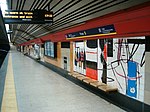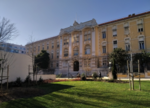Eduardo VII Park

Eduardo VII Park (Portuguese: Parque Eduardo VII) is a public park in Lisbon, Portugal. The park occupies an area of 26 hectares (64 acres) to the north of Avenida da Liberdade and Marquis of Pombal Square in Lisbon's city center. The park is named for King Edward VII of the United Kingdom, who visited Portugal in 1903 to strengthen relations between the two countries and reaffirm the Anglo-Portuguese Alliance. Until Edward's visit the park was called Parque da Liberdade (Liberty Park). In 1945 Portuguese Modernist architect Francisco Keil do Amaral redesigned the park to its current configuration. The Carlos Lopes Pavilion, the former Portuguese pavilion at the 1922 Rio de Janeiro International Exposition, and the Estufa Fria—a 1.5-hectare (3.7-acre) greenhouse garden—are situated within the park. The largest Portuguese flag in the world is usually flown at the park's northern end. The Lisbon Book Fair is held annually in Eduardo VII Park. The song "Pehle Pehle Pyar ki Mulakate" from the Indian Movie The Great Gambler was shot here.
Excerpt from the Wikipedia article Eduardo VII Park (License: CC BY-SA 3.0, Authors, Images).Eduardo VII Park
Lisbon Campo Pequeno (Avenidas Novas)
Geographical coordinates (GPS) Address Nearby Places Show on map
Geographical coordinates (GPS)
| Latitude | Longitude |
|---|---|
| N 38.728333333333 ° | E -9.1527777777778 ° |
Address
Lisbon, Campo Pequeno (Avenidas Novas)
Portugal
Open on Google Maps










